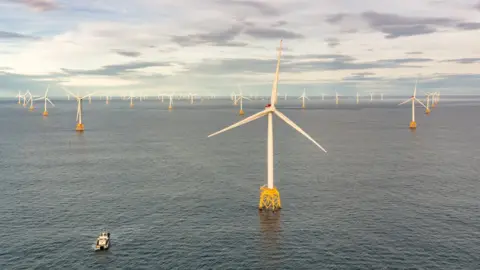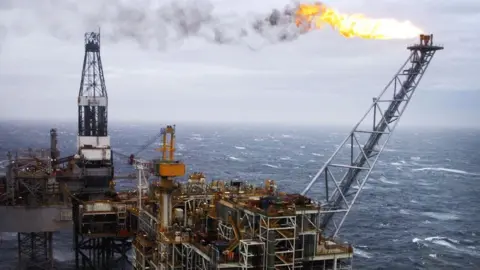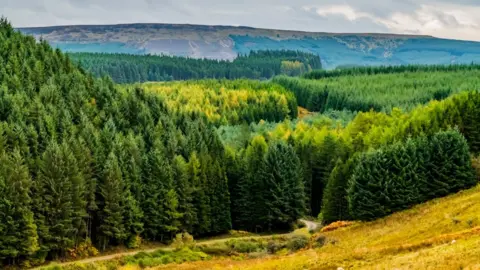Is Scotland still leading the way on climate change?
 Getty Images
Getty ImagesWhen world leaders gathered in Glasgow last year for the COP26 climate change summit, the Scottish government said its targets to reduce emissions were some of the toughest in the world.
This year, First Minister Nicola Sturgeon travelled to Egypt for COP27, where she urged world leaders to deliver on the climate pledges made in Glasgow.
But what are Scotland's climate change commitments - and how much progress has been made on them so far?
What are Scotland's renewable energy targets?
In 2011, the Scottish government set a target of generating the equivalent of 100% of "gross electricity consumption" from renewables by 2020.
However, it narrowly missed that target, having achieved a total of 98.6% consumption from renewables - minus net exports.
But this was up from 90.1% in 2019 and output has tripled in the last 10 years.
The Scottish government no longer reports against this complicated gross consumption target.
Instead, ministers want renewable energy generation to account for 50% of energy demand across electricity, heat and transport by 2030.
The new target goes beyond electricity and includes gas for heating and fuel for transport.
Scottish government data published in September shows that 26.7% of all of Scotland's energy consumption came from renewables in 2020.
Contributing to this renewables mix was onshore wind, which delivers about 70% of capacity, followed by hydro and offshore wind.
 SSE Renewables
SSE RenewablesGiant offshore wind projects have been credited with substantial increases in green energy output this year.
This includes the recently fully completed Moray East development which has 100 giant turbines and the Beatrice offshore wind farm which went into operation in 2019 and is capable of generating enough power for 450,000 homes.
Also aiding the renewables drive has been Scotland moving away from burning fossil fuels, with the last coal-fired power station, Longannet, closing in 2016.
The only remaining gas-fired power station is at Peterhead in Aberdeenshire, which its owners SSE want to rebuild with carbon capture and storage technology attached.
What about greenhouse gas emissions?
The Scottish government has set a legally-binding target to cut greenhouse gas emissions to net zero by 2045, five years ahead of the date set for the UK as a whole.
Net zero means any emissions will be balanced out by schemes to offset an equivalent amount of greenhouse gases from the atmosphere - such as planting trees, or using technology to capture carbon and store it.
The Scottish government believes its targets are "the toughest anywhere in the world".
However, other countries - such as Sweden - have passed legislation with the same goal. Sweden did so two years before Scotland, and it has also set milestones along the way.
But Scotland's milestone targets are more ambitious and include emissions from aviation and shipping.
They also don't rely on international credits, which is where countries can pay for emissions to be reduced elsewhere instead of reducing their own.
So how are things going? Well emissions of greenhouse gases - such as carbon dioxide - have already been reduced to about half of what they were 30 years ago.
 PA Media
PA MediaThe latest available figures are for 2020 and show Scotland's greenhouse gas emissions fell by 12%.
The drop meant the Scottish government met its target to cut adjusted emissions by 56% since 1990.
However, the drop came in a year when Covid lockdown restrictions took effect and had a big impact on most people's routines.
For example, international aviation emissions decrease of 67.7% as flights were grounded and holidays cancelled.
Environmental groups are concerned that emissions will bounce back in future years and they argue a clearer breakdown of how annual targets will be achieved is needed.
A Scottish government-appointed commission has made 24 recommendations on how to achieve an "orderly, managed transition to net-zero".
What about oil and gas?
One of the biggest controversies since the COP26 summit in Glasgow has been the future of the oil and gas industry.
The UK has opened a new licensing round for companies to explore nearly 900 locations for oil and gas in the North Sea.
The decision is at odds with international climate scientists who say fossil fuel projects should be closed down, not expanded.
 PA Media
PA MediaThe move has made potential new developments such as Cambo, an oil field west of Shetland thought to contain 800 million barrels of oil, political hot potatoes.
The UK government has said new exploration and licences will boost energy security and support skilled jobs.
But Nicola Sturgeon said she had not seen any evidence to justify the expansion on environmental or energy security grounds.
What about transport?
Transport accounts for about a quarter of Scotland's greenhouse gas emissions. Some steps have been taken to reduce this, but the overwhelming majority of vehicles on the road are still greenhouse gas-emitting petrol or diesel engines.
The Scottish government has said it wants to have "phased out" the need for new petrol and diesel cars by 2030 - and hopes to reduce the use of cars generally, with the number of kilometres driven to be reduced by 20%.
The number of new electric and hybrid cars registered in the UK is soaring and the availability of publicly available charge points in Scotland is now at 2,200 and increasing.
 Getty Images
Getty ImagesLow emission zones that will see polluting vehicles banned from entering city and town centres are now formally in place in Edinburgh, Glasgow, Aberdeen and Dundee in a bid to improve air quality.
The rules are not yet being enforced but when they are motorists could face a £60 fine.
The Covid pandemic had a major impact on travel patterns with public transport journeys falling by 70% in 2020/21 compared with the previous year, according to latest Transport Scotland data.
Since then, ScotRail has said its peak-time commuter services will not return to pre-pandemic levels and bus services have also failed to recover following the lifting of restrictions.
Road traffic also fell during the pandemic - by 22% in 2020-21 - but not as markedly as the use of public transport.
Air passenger numbers, which had increased by 28% in the 10 years prior to the pandemic, fell by 76% in 2020-21 and have been increasing since then as more people venture overseas.
Heating homes
Since COP26, the cost of gas and electricity has dominated the headlines.
About 13% of Scotland's emissions come from housing, with most homes (about 80%) still relying on gas central heating systems.
The target set by ministers is that about 50% of all homes will need to convert to a zero or low-emissions heating system by 2030.
 Getty Images
Getty ImagesInstead of gas, heating systems should use renewable energy, or rely on low-carbon alternatives such as heat pumps.
Soaring energy prices have meant those who can afford it have increased demand for home renewables with solar firms struggling to cope with the interest.
About 20,000 households have benefited from better insulation and new, more efficient - although still often gas - heating systems, funded by the Scottish government.
But the Scottish government has faced recent criticism as revisions to its 2023/24 budget include proposals for almost £133m worth of cuts to energy efficiency schemes.
The schemes aim to improve the efficiency of public buildings and help people insulate their homes.
Planting trees
 Getty Images
Getty ImagesTrees are still the most effective way of absorbing CO2 from the atmosphere.
To meet targets, the UK needs a net increase of 32,000 hectares of woodland planted every year for the next 30 years - equating to about 1.5 billion trees.
Figures show most of the trees planted in the UK were planted in Scotland - 10,480 of the 13,840 hectares planted in 2021-22.
This is below the target for that year of 13,500 hectares but came in a year of severe winter storms, such as Arwen.
By 2024, the Scottish government aims to be creating 18,000 hectares of new woodlands per year, with the ultimate goal of having 21% of Scotland's land covered by forest by 2032.



